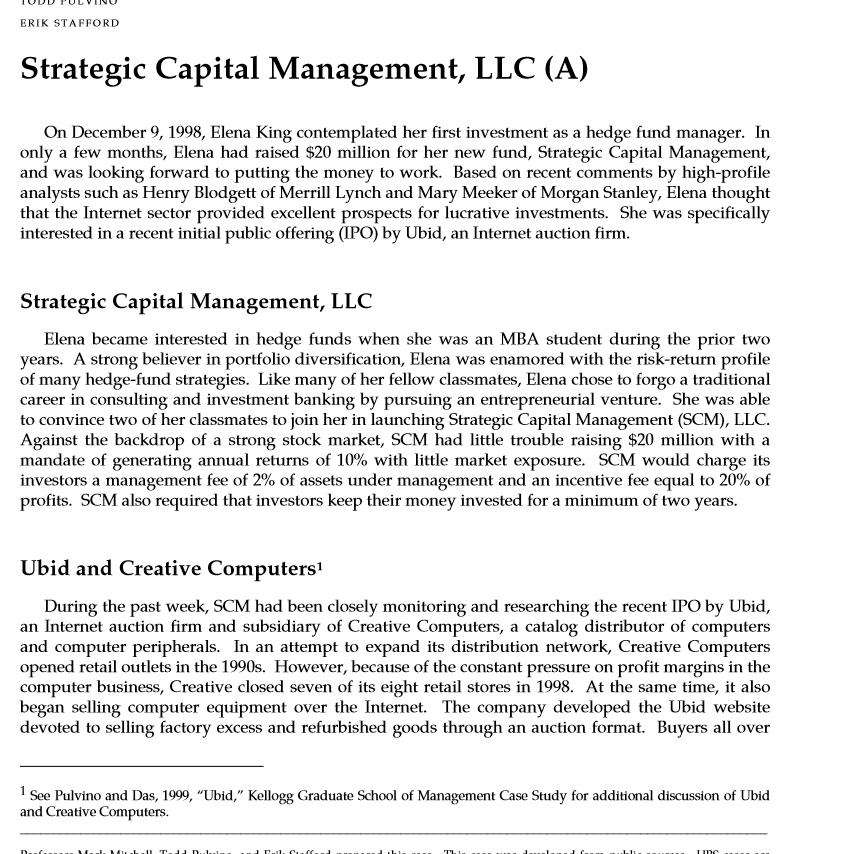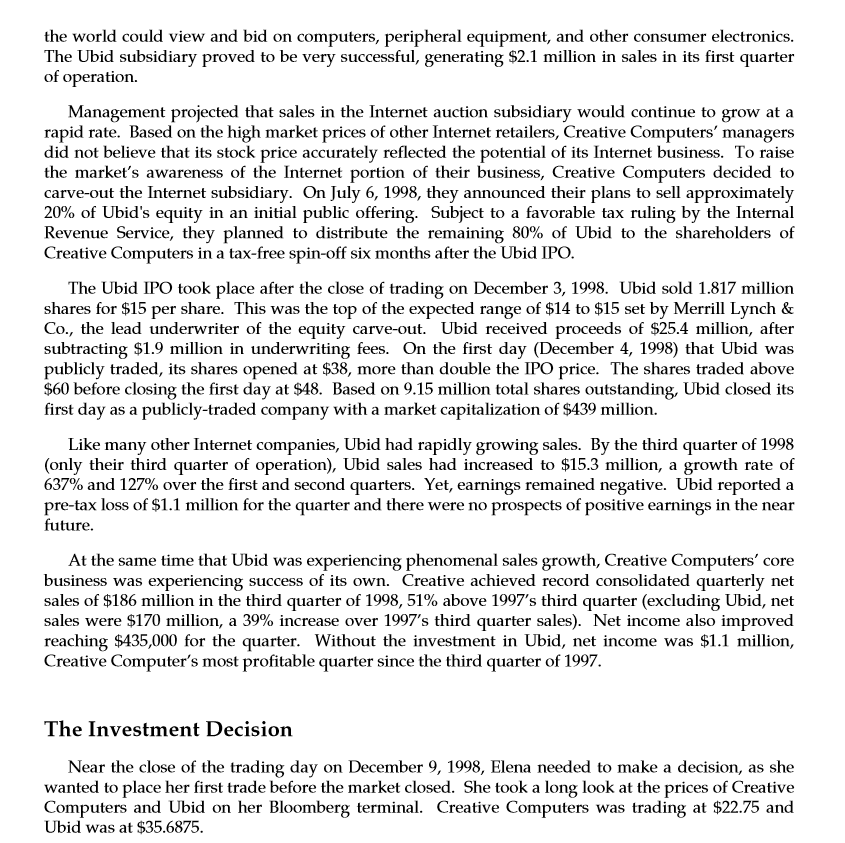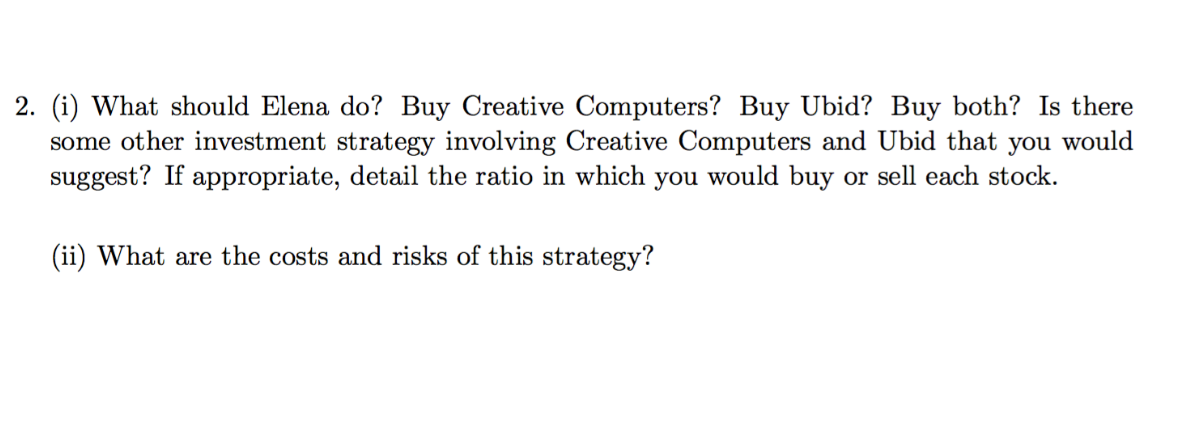




TUUD PULVINU ERIK STAFFORD Strategic Capital Management, LLC (A) On December 9, 1998, Elena King contemplated her first investment as a hedge fund manager. In only a few months, Elena had raised $20 million for her new fund, Strategic Capital Management, and was looking forward to putting the money to work. Based on recent comments by high-profile analysts such as Henry Blodgett of Merrill Lynch and Mary Meeker of Morgan Stanley, Elena thought that the Internet sector provided excellent prospects for lucrative investments. She was specifically interested in a recent initial public offering (IPO) by Ubid, an Internet auction firm. Strategic Capital Management, LLC Elena became interested in hedge funds when she was an MBA student during the prior two years. A strong believer in portfolio diversification, Elena was enamored with the risk-return profile of many hedge-fund strategies. Like many of her fellow classmates, Elena chose to forgo a traditional career in consulting and investment banking by pursuing an entrepreneurial venture. She was able to convince two of her classmates to join her in launching Strategic Capital Management (SCM), LLC. Against the backdrop of a strong stock market, SCM had little trouble raising $20 million with a mandate of generating annual returns of 10% with little market exposure. SCM would charge its investors a management fee of 2% of assets under management and an incentive fee equal to 20% of profits. SCM also required that investors keep their money invested for a minimum of two years. Ubid and Creative Computersi During the past week, SCM had been closely monitoring and researching the recent IPO by Ubid, an Internet auction firm and subsidiary of Creative Computers, a catalog distributor of computers and computer peripherals. In an attempt to expand its distribution network, Creative Computers opened retail outlets in the 1990s. However, because of the constant pressure on profit margins in the computer business, Creative closed seven of its eight retail stores in 1998. At the same time, it also began selling computer equipment over the Internet. The company developed the Ubid website devoted to selling factory excess and refurbished goods through an auction format. Buyers all over 1 See Pulvino and Das, 1999, "Ubid," Kellogg Graduate School of Management Case Study for additional discussion of Ubid and Creative Computers. the world could view and bid on computers, peripheral equipment, and other consumer electronics. The Ubid subsidiary proved to be very successful, generating $2.1 million in sales in its first quarter of operation. Management projected that sales in the Internet auction subsidiary would continue to grow at a rapid rate. Based on the high market prices of other Internet retailers, Creative Computers' managers did not believe that its stock price accurately reflected the potential of its Internet business. To raise the market's awareness of the Internet portion of their business, Creative Computers decided to carve-out the Internet subsidiary. On July 6, 1998, they announced their plans to sell approximately 20% of Ubid's equity in an initial public offering. Subject to a favorable tax ruling by the Internal Revenue Service, they planned to distribute the remaining 80% of Ubid to the shareholders of Creative Computers in a tax-free spin-off six months after the Ubid IPO. The Ubid IPO took place after the close of trading on December 3, 1998. Ubid sold 1.817 million shares for $15 per share. This was the top of the expected range of $14 to $15 set by Merrill Lynch & Co., the lead underwriter of the equity carve-out. Ubid received proceeds of $25.4 million, after subtracting $1.9 million in underwriting fees. On the first day (December 4, 1998) that Ubid was publicly traded, its shares opened at $38, more than double the IPO price. The shares traded above $60 before closing the first day at $48. Based on 9.15 million total shares outstanding, Ubid closed its first day as a publicly-traded company with a market capitalization of $439 million. Like many other Internet companies, Ubid had rapidly growing sales. By the third quarter of 1998 (only their third quarter of operation), Ubid sales had increased to $15.3 million, a growth rate of 637% and 127% over the first and second quarters. Yet, earnings remained negative. Ubid reported a pre-tax loss of $1.1 million for the quarter and there were no prospects of positive earnings in the near future. At the same time that Ubid was experiencing phenomenal sales growth, Creative Computers' core business was experiencing success of its own. Creative achieved record consolidated quarterly net sales of $186 million in the third quarter of 1998, 51% above 1997's third quarter (excluding Ubid, net sales were $170 million, a 39% increase over 1997's third quarter sales). Net income also improved reaching $435,000 for the quarter. Without the investment in Ubid, net income was $1.1 million, Creative Computer's most profitable quarter since the third quarter of 1997. The Investment Decision Near the close of the trading day on December 9, 1998, Elena needed to make a decision, as she wanted to place her first trade before the market closed. She took a long look at the prices of Creative Computers and Ubid on her Bloomberg terminal. Creative Computers was trading at $22.75 and Ubid was at $35.6875. Te mvesunen Vecision Near the close of the trading day on December 9, 1998, Elena needed to make a decision, as she wanted to place her first trade before the market closed. She took a long look at the prices of Creative Computers and Ubid on her Bloomberg terminal. Creative Computers was trading at $22.75 and Ubid was at $35.6875. is authorized for use only by Kristen Cerne (cerne.9@osu.edu). Copying or posting is an infringement of copyright. Please contact customerservice@harvardbusiness.org or 800-988-0886 for additional copies. Strategic Capital Management, LLC (A) 202-024 Exhibit 1 Consolidated Balance Sheet for Creative Computers, Inc. on September 30, 1998 (Thousands of Dollars) Assets Cash and Equivalents Accounts Receivable Inventory Other Current Assets Property, Plant and Equipment, Net Other Long-Term Assets Liabilities & Stockholder's Equity 15,528 Accounts Payable 40,564 Short-Term Debt 44,958 Other Current Liabilities 12,428 Capital Leases 15,040 Notes Payable 14,313 Stockholder's Equity 75,877 2,969 15,336 29 154 48,466 Total Assets 142,831 142,831 2. (i) What should Elena do? Buy Creative Computers? Buy Ubid? Buy both? Is there some other investment strategy involving Creative Computers and Ubid that you would suggest? If appropriate, detail the ratio in which you would buy or sell each stock. (ii) What are the costs and risks of this strategy? Exhibit 1 Consolidated Balance Sheet for Creative Computers, Inc. on September 30, 1998 (Thousands of Dollars) Assets Cash and Equivalents Accounts Receivable Inventory Other Current Assets Property, Plant and Equipment, Net Other Long-Term Assets Liabilities & Stockholder's Equity 15,528 Accounts Payable 40,564 Short-Term Debt 44,958 Other Current Liabilities 12,428 Capital Leases 15,040 Notes Payable 14,313 Stockholder's Equity 75.877 2,969 15,336 29 154 48,466 Total Assets 142,831 142,831 Source: Annual Reports. Creative Computers has 10,238,703 shares outstanding on December 9, 1998. Exhibit 2 Consolidated Balance Sheet for Ubid, Inc. on September 30, 1998 (Thousands of Dollars) Assets Accounts Receivable Inventory Other Current Assets Property, Plant and Equipment, Net Other Long-Term Assets 499 4,498 10 302 739 Liabilities & Stockholder's Equity Accounts Payable Other Current Liabilities Advances from the Parent Stockholder's Equity 4,760 871 3,709 -3,292 Total Assets 6,048 6,048 Source: Annual Reports. Ubid has 9,146,883 shares outstanding on December 9, 1998. TUUD PULVINU ERIK STAFFORD Strategic Capital Management, LLC (A) On December 9, 1998, Elena King contemplated her first investment as a hedge fund manager. In only a few months, Elena had raised $20 million for her new fund, Strategic Capital Management, and was looking forward to putting the money to work. Based on recent comments by high-profile analysts such as Henry Blodgett of Merrill Lynch and Mary Meeker of Morgan Stanley, Elena thought that the Internet sector provided excellent prospects for lucrative investments. She was specifically interested in a recent initial public offering (IPO) by Ubid, an Internet auction firm. Strategic Capital Management, LLC Elena became interested in hedge funds when she was an MBA student during the prior two years. A strong believer in portfolio diversification, Elena was enamored with the risk-return profile of many hedge-fund strategies. Like many of her fellow classmates, Elena chose to forgo a traditional career in consulting and investment banking by pursuing an entrepreneurial venture. She was able to convince two of her classmates to join her in launching Strategic Capital Management (SCM), LLC. Against the backdrop of a strong stock market, SCM had little trouble raising $20 million with a mandate of generating annual returns of 10% with little market exposure. SCM would charge its investors a management fee of 2% of assets under management and an incentive fee equal to 20% of profits. SCM also required that investors keep their money invested for a minimum of two years. Ubid and Creative Computersi During the past week, SCM had been closely monitoring and researching the recent IPO by Ubid, an Internet auction firm and subsidiary of Creative Computers, a catalog distributor of computers and computer peripherals. In an attempt to expand its distribution network, Creative Computers opened retail outlets in the 1990s. However, because of the constant pressure on profit margins in the computer business, Creative closed seven of its eight retail stores in 1998. At the same time, it also began selling computer equipment over the Internet. The company developed the Ubid website devoted to selling factory excess and refurbished goods through an auction format. Buyers all over 1 See Pulvino and Das, 1999, "Ubid," Kellogg Graduate School of Management Case Study for additional discussion of Ubid and Creative Computers. the world could view and bid on computers, peripheral equipment, and other consumer electronics. The Ubid subsidiary proved to be very successful, generating $2.1 million in sales in its first quarter of operation. Management projected that sales in the Internet auction subsidiary would continue to grow at a rapid rate. Based on the high market prices of other Internet retailers, Creative Computers' managers did not believe that its stock price accurately reflected the potential of its Internet business. To raise the market's awareness of the Internet portion of their business, Creative Computers decided to carve-out the Internet subsidiary. On July 6, 1998, they announced their plans to sell approximately 20% of Ubid's equity in an initial public offering. Subject to a favorable tax ruling by the Internal Revenue Service, they planned to distribute the remaining 80% of Ubid to the shareholders of Creative Computers in a tax-free spin-off six months after the Ubid IPO. The Ubid IPO took place after the close of trading on December 3, 1998. Ubid sold 1.817 million shares for $15 per share. This was the top of the expected range of $14 to $15 set by Merrill Lynch & Co., the lead underwriter of the equity carve-out. Ubid received proceeds of $25.4 million, after subtracting $1.9 million in underwriting fees. On the first day (December 4, 1998) that Ubid was publicly traded, its shares opened at $38, more than double the IPO price. The shares traded above $60 before closing the first day at $48. Based on 9.15 million total shares outstanding, Ubid closed its first day as a publicly-traded company with a market capitalization of $439 million. Like many other Internet companies, Ubid had rapidly growing sales. By the third quarter of 1998 (only their third quarter of operation), Ubid sales had increased to $15.3 million, a growth rate of 637% and 127% over the first and second quarters. Yet, earnings remained negative. Ubid reported a pre-tax loss of $1.1 million for the quarter and there were no prospects of positive earnings in the near future. At the same time that Ubid was experiencing phenomenal sales growth, Creative Computers' core business was experiencing success of its own. Creative achieved record consolidated quarterly net sales of $186 million in the third quarter of 1998, 51% above 1997's third quarter (excluding Ubid, net sales were $170 million, a 39% increase over 1997's third quarter sales). Net income also improved reaching $435,000 for the quarter. Without the investment in Ubid, net income was $1.1 million, Creative Computer's most profitable quarter since the third quarter of 1997. The Investment Decision Near the close of the trading day on December 9, 1998, Elena needed to make a decision, as she wanted to place her first trade before the market closed. She took a long look at the prices of Creative Computers and Ubid on her Bloomberg terminal. Creative Computers was trading at $22.75 and Ubid was at $35.6875. Te mvesunen Vecision Near the close of the trading day on December 9, 1998, Elena needed to make a decision, as she wanted to place her first trade before the market closed. She took a long look at the prices of Creative Computers and Ubid on her Bloomberg terminal. Creative Computers was trading at $22.75 and Ubid was at $35.6875. is authorized for use only by Kristen Cerne (cerne.9@osu.edu). Copying or posting is an infringement of copyright. Please contact customerservice@harvardbusiness.org or 800-988-0886 for additional copies. Strategic Capital Management, LLC (A) 202-024 Exhibit 1 Consolidated Balance Sheet for Creative Computers, Inc. on September 30, 1998 (Thousands of Dollars) Assets Cash and Equivalents Accounts Receivable Inventory Other Current Assets Property, Plant and Equipment, Net Other Long-Term Assets Liabilities & Stockholder's Equity 15,528 Accounts Payable 40,564 Short-Term Debt 44,958 Other Current Liabilities 12,428 Capital Leases 15,040 Notes Payable 14,313 Stockholder's Equity 75,877 2,969 15,336 29 154 48,466 Total Assets 142,831 142,831 2. (i) What should Elena do? Buy Creative Computers? Buy Ubid? Buy both? Is there some other investment strategy involving Creative Computers and Ubid that you would suggest? If appropriate, detail the ratio in which you would buy or sell each stock. (ii) What are the costs and risks of this strategy? Exhibit 1 Consolidated Balance Sheet for Creative Computers, Inc. on September 30, 1998 (Thousands of Dollars) Assets Cash and Equivalents Accounts Receivable Inventory Other Current Assets Property, Plant and Equipment, Net Other Long-Term Assets Liabilities & Stockholder's Equity 15,528 Accounts Payable 40,564 Short-Term Debt 44,958 Other Current Liabilities 12,428 Capital Leases 15,040 Notes Payable 14,313 Stockholder's Equity 75.877 2,969 15,336 29 154 48,466 Total Assets 142,831 142,831 Source: Annual Reports. Creative Computers has 10,238,703 shares outstanding on December 9, 1998. Exhibit 2 Consolidated Balance Sheet for Ubid, Inc. on September 30, 1998 (Thousands of Dollars) Assets Accounts Receivable Inventory Other Current Assets Property, Plant and Equipment, Net Other Long-Term Assets 499 4,498 10 302 739 Liabilities & Stockholder's Equity Accounts Payable Other Current Liabilities Advances from the Parent Stockholder's Equity 4,760 871 3,709 -3,292 Total Assets 6,048 6,048 Source: Annual Reports. Ubid has 9,146,883 shares outstanding on December 9, 1998











